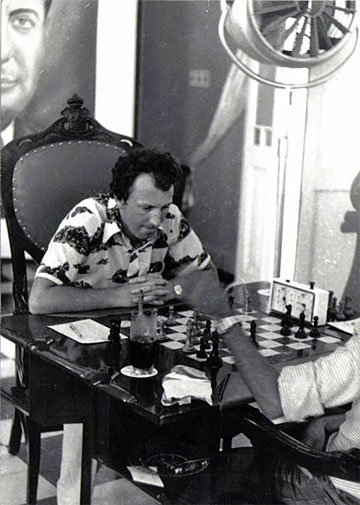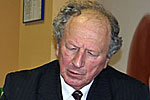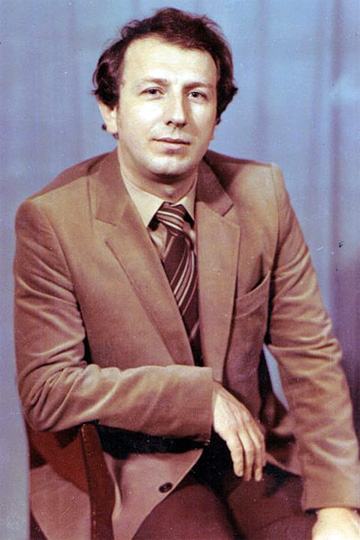Evgeny Sveshnikov turns sixty

Evgeny Ellinovich Sveshnikov was born in Cheliabinsk, Russia, on February 11,
1950. At the age of seventeen he played in his first USSR Chess Championship,
became an IM at 25 and a GM at 27. Just before that he had been selected as
a reserve for the Soviet side participating at the Moscow 1977 European Team
Championship. At that event he scored a sensational 80%, winning individual
and team gold medals.
On January 10th 1984 Sveshnikov was diagnosed with third stage cancer. On that
day he went to a photographer to have the above portrait made – for his
children. He survived and has gone on to lead a normal life.

Recovering in the summer of 1985 a strawberry plantation near Vichy in France
Sveshnikov is respected by his peers as a deep and original thinker and a master
tactician. He is also one of the most outspoken grandmasters on the circuit.
In recent years he has campaigned to protect gamescores, which he believes are
the intellectual property of the players and therefore should be subject to
copyright laws. He does not advocate handing over such detailed information
to future opponents, who can use the information to improve their chances of
victory.
Naturally Sveshnikov is, first and foremost, known as a theoretician whose
name is permanently linked with the moves 1.e4 c5 2.Nf3 Nc6 3. d4 cxd4
4.Nxd4 Nf6 5.Nc3 e5. This variation is also known as the Lasker-Pelikan
or Cheliabinsk Variation, but "Sveshnikov Variation" is the name that
has stuck for this line, which is one of the most popular and fascinating replies
to 1.e4.
The Sveshnikov 'proper' continues 6.Ndb5 d6. Right from the
beginning, Black is striving for active and dynamic counterplay, and this results
in a double-edged struggle for the initiative. During the sixties and seventies
of the 20th century Sveshnikov worked out the details of the system with his
close friend Grandmaster Gennadi Timoshchenko. Today, it firmly belongs to the
repertoire of many outstanding players like Kasparov, Kramnik, Shirov, Leko,
Lautier, Radjabov and Khalifman.
Sveshnikov has also been a pioneer in the development of the Advance Variation
of the French Defence and of the Alapin Variation of the Sicilian Defence.
 The
life of the master
The
life of the master
The following pictures were kindly provided by the Russian news site ChessPro,
which has published a very extensive anniversary
portrait to celebrate Evgeny Ellinovich's 60th birthday. The authors of
the report are Vladimir Barsky and Maria Fominykh.

The above picture was taken in March 1967 in Sochi, during a session of the
All-Russia Chess School of GM Igor Zakharovich Bondarevsky and well-known coach
Victor E. Golenishcheva. The 17-year-old Evgeny Sveshnikov is in the second
row to the left, in front of him is the 15-year-old Anatoly Karpov.

In 1972 Evgeny graduated and began working as a research engineer at the department
of internal combustion engines. "I worked in the laboratory for 10-12 hours
a day," he told the ChessPro authors. "Under laboratory conditions,
by changing the shape of the combustion chamber and increasing the degree of
boost we managed to get 100 horsepower from a single cylinder engine of a tank.
At the time the maximum was 45-50 hp. Today, tanks have twelve cylinders and
1200 horsepower. All my life I will remember the saying of my boss, Dr Gennady
Borisovich Dragunov: 'The laws of physics are there to be circumvented by other
laws.' At the time I decided to become a chess professional, I had almost finished
my PhD thesis on the shape of the combustion chamber."

The above slightly blurry picture was taken during the USSR championship in
1973 at the end of a game Tal-Sveshnikov, with the arbiters (on the right Lev
Abramov) signalling the audience to be quiet. Mikhail Tal is smiling because
he is relieved to have escaped with a draw. In the background on the left is
Paul Keres.

A picture from the 1977 USSR Championship in Leningrad between Vassily Smyslov
and Evgeny Sveshnikov. In 45 games against World Champions Sveshnikov has an
overall score of –1.

In the above picture from 1978, Sveshnikov is playing in Cienfuegos, Cuba.
In the ChessPro article he recalls that the country was idyllically beautiful,
like a scene from the "Bounty" – sand, palm trees, swimming
in the sea. "We were warned to look out for sharks in the bay, so one player
stood watch while the others swam. I was in the water with the young Artur Yusupov
when suddenly I felt a terrible pain. Artur rushed to my assistance and then
he started screaming in pain. We had stepped on sea urchins! Artur had 30 spines
in his foot – and still had a game to play on that day. We were taken
to the hospital for treatment, which consists of disinfecting the wounds with
iodine. The spines are left in the foot, where they dissolve after two weeks."
In Cienfuegos Sveshnikov took the first place, Yusupov came third. "Second
place went to the American Larry Christiansen. At the closing we all received
our cash prizes, the Soviet participants in pesos, the Americans in dollars.
I suggested to Larry that we exchange his second prize for my first, but he
waved his arms and screamed 'No, no, no!' We were able to exchange our pesos
at the embassy, but we had to pay a tax to the state, in my case seven thousand
dollars. And that in a country where an automobile cost $1,500. So I paid up
for five Ladas!"

The above picture is from the opening of the USSR championship in Tiblisi,
December 1978. It shows (from left to right): Tamaz Giorgadze, Garry Kasparov,
Sergey Makarychev, Oleg Romanishin, Alexander Beliavsky, Yuri Razuvaev, Vitaly
Tseshkovsky, Naum Rashkovskii and Evgeny Sveshnikov. 15-year-old Gary Kasparov's
debut was very successful: he scored 50%, which nobody expected. "In our
game, I was playing white," says Sveshnikov. "I had just sacrificed
a pawn, when the hall lights went out. The game was interrupted and I offered
Garry a draw, which he took. In 1981 in Frunze, Kasparov was battling with Psakhis
for first place. His last white game was against me, and I made an easy draw
in 22 moves." Psakhis and Kasparov tied for first with 12.5/17, 2.5 points
ahead of the field. Sveshnikov finished equal 10-13th with 8.0 points.

For ten years Evgeny Sveshnikov led the All-Russia Chess School, which has
many talented students but too few GM coaches. "It took me several years
to acquire the necessary experience for the job. The first steps in the coaching
assignments were quite difficult. I began with what I know best – the
opening. I was well aware that endgame training was also needed, and in the
late eighties I began to teach the endgame as well."

In the picture above is Sveshnikov’s second wife, Lyudmila, and his son
Vova. The couple met in Riga in 1985, and still live in the city. In 1985, Sveshnikov
split from his first wife. He had wanted to move to Moscow, but was refused
a residence permit. He was told that it was because he had the two young daughters,
who would then be entited to move to Moscow with him. The police chief told
him: "If they both drop dead, you can have a permit". Sveshnikov challenged
the decision through the courts, all the way to the Supreme Court, but failed
to overtun the decision. His daughters remained in Chelyabinsk with his first
wife.

Speaking with Boris Spassky at a dinner. Seated on the left is GM Ron Henley,
on the right Anatoly Karpov
Now that he has reached the milestone of 60, Sveshnikov becomes eligible to
play in veterans events, including the World Senior Championship. But on this
subject, like so many others, the garndmaster has his own opinions: "Why
should veterans start at 60? Better at 50. By then, one's results decline sharply,
and nobody over 50 is in the world top 100. Why do junior events have seven
different age categories, but veterans' chess only one? I think it would be
better to have a 50-65 category, and an over-65 category." A man of decided,
original opinions.
Read
the full article by Vladimir Barsky and Maria Fominykh in ChessPro (Russian
language)
Learn the Sveshnikov with contemporary experts

Alexei Shirov: My best games in the Sveshnikov
The Sveshnikov is an opening tailor-made for Alexei Shirov (FIDE World Cup
finalist in 2007), who plays it with both white and black and knows the tricks
and traps all too well. In more than four hours of video, the genius from Latvia
presents his best Sveshnikov games, showing the spectator typical opening plans
for both sides, explaining the strategy and tactics in the middlegame and how
to convert advantages in the endgame – and all this in a most entertaining way.
Video running time: four hours.

|
Loek van Wely:
The Sveshnikov Variation of the Sicilian
Dutch top grandmaster and six-times national champion Loek van Wely has
played the Sveshnikov since 1998. On this DVD he comments on his latest
encounters with world-class players like Shirov, Anand, Topalov and Kramnik.
As one would expect in the Sveshnikov, the games abound with combinatorial
ideas and sacrifices; a feast for all fans of tactics. Van Wely focuses
on the main variations 1.e4 c5 2.Nf3 Nc6 3. d4 cxd4 4.Nxd4 Nf6 5.Nc3 e5
6.Ndb5 d6 7.Bg5 a6 8.Na3 b5 9.Nd5 Be7 10.Bxf6 Bxf6 11.c3 Bg5 12.Nc2 and
1.e4 c5 2.Nf3 Nc6 3. d4 cxd4 4.Nxd4 Nf6 5.Nc3 e5 6.Ndb5 d6 7.Bg5 a6 8.Na3
b5 9.Bxf6 gxf6 10.Nd5 f5. Video playing time: 3 h 43 min
|























 The
life of the master
The
life of the master















